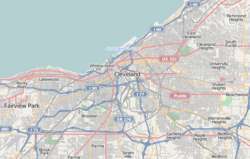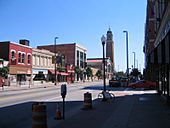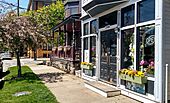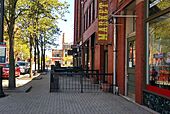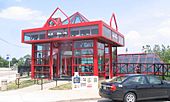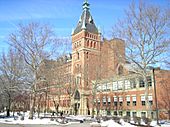Ohio City, Cleveland facts for kids
Quick facts for kids
Ohio City
|
|
|---|---|
|
Neighborhood of Cleveland
|
|
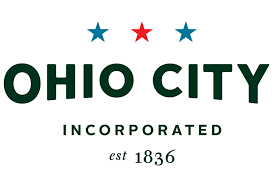 |
|
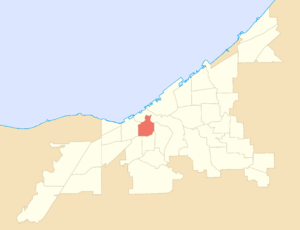 |
|
| Country | United States |
| State | Ohio |
| County | Cuyahoga County |
| City | Cleveland |
| Population
(2020)
|
|
| • Total | 8,389 |
| Demographics | |
| • White | 60.4% |
| • Black | 28.1% |
| • Hispanic (of any race) | 14.6% |
| • Asian and Pacific Islander | 2.1% |
| • Mixed and Other | 9.4% |
| Time zone | UTC-5 (EST) |
| • Summer (DST) | UTC-4 (EDT) |
| ZIP Codes |
44113, 44102
|
| Area code(s) | 216 |
| Median income | $40,170 |
| Source: 2020 U.S. Census, City Planning Commission of Cleveland | |
|
Ohio City Preservation District
|
|
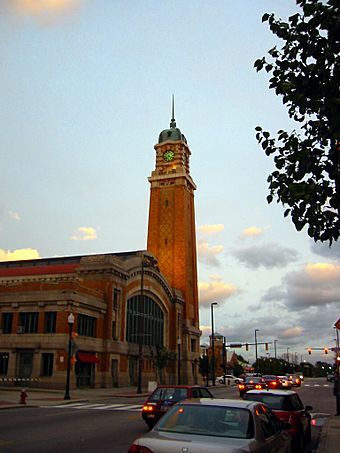
The West Side Market
|
|
| Location | Roughly Franklin Blvd. NW., W. 38th St., Bridge Ave. NW., & W. 44th St., & Stone, W. 25th, Bridge Ave. NW., & W. 28th, Cleveland, Ohio |
|---|---|
| Architectural style | Greek Revival, Italianate, Queen Anne |
| NRHP reference No. | 89000435 |
| Added to NRHP | May 25, 1989 |
Ohio City is one of the oldest neighborhoods in Cleveland, Ohio. It is located right next to the Cuyahoga River. This area has a rich history and many cool places to explore.
Contents
A Look Back: Ohio City's Beginnings
Ohio City started as its own town on March 3, 1836. It separated from Brooklyn Township. The town grew quite a bit, from about 2,400 people in the early 1830s to over 4,000 by 1850. However, on June 5, 1854, Ohio City became part of Cleveland.
Famous People from Ohio City
James A. Garfield, who later became the 20th president of the United States, often gave speeches at Franklin Circle Christian Church in 1857. This church is located where Franklin Boulevard and Fulton Road meet.
Ohio City is also the birthplace of John Heisman. He is famous for the annual Heisman Trophy, which is given to the best player in college football. John Heisman was born in the neighborhood in 1869. A special marker from the Ohio Historical Society stands near Bridge Avenue and West 29th Place to remember him.
Cool Places to Visit in Ohio City
Ohio City has many interesting spots, especially in its main business area.
The Historic West Side Market
The most famous place is the West Side Market, built in 1912. This market looks like a European market and is located at Lorain Avenue and West 25th Street. About one million people visit it every year!
Near the West Side Market, you'll find The Ohio City Fresh Food Collaborative. This is one of the biggest urban farms in America. It includes a farm, a store to buy fresh food, and a community kitchen. All of this is on a large 6-acre piece of land in the city.
Breweries and Local Businesses
Ohio City has the most craft breweries in Cleveland. Some of these include Hansa Brewing, Market Garden Brewery, Nanobrew, Platform Beer, Saucy Brew Works, and Bad Tom Smith Brewing. The oldest microbrewery in Ohio, the Great Lakes Brewing Company, is also here. Both Market Garden and Great Lakes have big restaurants and breweries near the West Side Market.
Schools and Hostels
Saint Ignatius High School is a Jesuit school that prepares students for college. It is located close to the West Side Market. Founded in 1886, the school has many successful graduates and is known for its sports teams.
The Cleveland Hostel opened in 2012 and is the only hostel in Cleveland. It's on West 25th Street and Chatham Avenue, right next to the W.25th Street Station. This station is part of the RTA Red Line.
Art and History
The Transformer Station, located at Church and West 29th Street, is a special art gallery. It's the only extra location for the Cleveland Museum of Art and mainly shows modern art.
St. John's Episcopal Church, at Church and West 26th Street, is the oldest church building in Cuyahoga County. It was an important stop on the Underground Railroad in Northeast Ohio. You can still see parts of a tunnel entrance in the basement that led to the nearby Cuyahoga River.
The Carnegie West Branch of Cleveland Public Library has been open since 1910. It was designed by Edward Tilton, who also designed buildings on Ellis Island in New York. The library has a beautiful old-style exterior.
Ohio City Today
In recent years, Ohio City has seen a lot of new buildings and growth. This has brought in young professionals, small breweries, artists, and unique local shops and restaurants. It is now seen as one of Ohio's most popular and welcoming neighborhoods for everyone.
Who Lives in Ohio City?
The people living in Ohio City have changed a lot over time. It was first home to many English and German families. Then, in the early 1900s, many immigrants from Eastern Europe moved there.
In the 1960s and 1970s, as Cleveland grew, some wealthier families moved to nearby suburbs like Parma and Lakewood. This led to more African American families moving into Ohio City. The number of Latino families has also grown.
Recently, the Cleveland City Council has encouraged people to move back to Ohio City with tax benefits. This has made the community very diverse, with people from many different backgrounds living together.
Gallery
See also
 In Spanish: Ohio City para niños
In Spanish: Ohio City para niños


